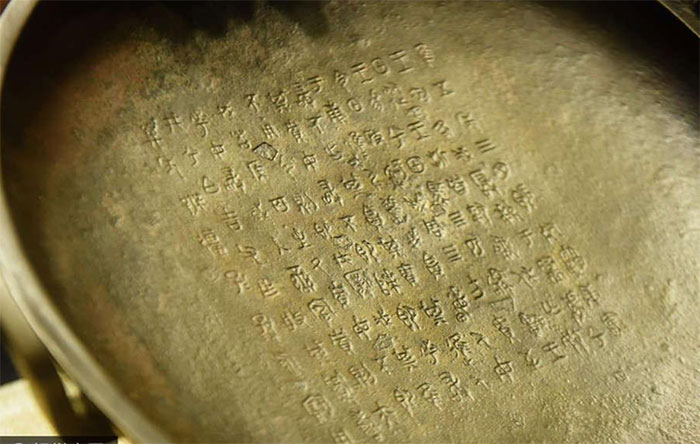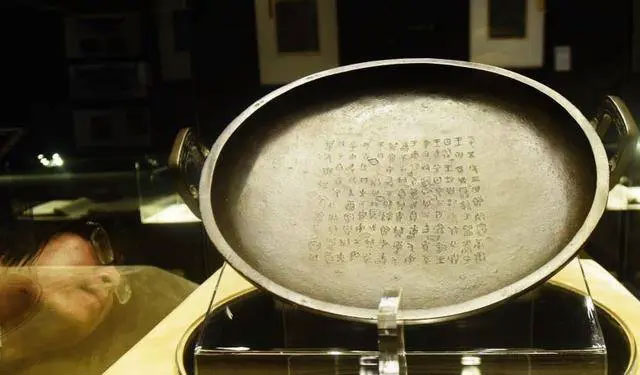The 'national treasure' that once became a frying pan, a young man bought it for 300 USD, unexpectedly the price was more than half a ton of gold
This treasure was once scattered everywhere, even becoming a frying pan, but it turned out to be worth more than half a ton of gold. What is it?
Some antiques at first look ordinary but turn out to be rare treasures in the world with great value.
The treasure called He Jia Ban ( or He Jia Tray) is a proof. This is a bronze tray crafted in 823 BC, during the Western Zhou Dynasty (1046 BC – 771 BC). According to archaeologists, this tray is 11.7 cm high, 47 cm wide, with handles on both sides. Notably, the tray is engraved with more than 130 characters to record a famous historical event during the Western Zhou Dynasty.

This bronze tray has 133 characters engraved on it with content related to the Western Zhou Dynasty. (Photo: Chinadaily).
The He Jia tray was named after Yin Gefu , the Duke of Yin, a vassal state of the Western Zhou Dynasty. He was also the one who contributed greatly to the collection of the Book of Songs, the first collection of Chinese poetry. The ancient tray was excavated during the Song Dynasty (960 – 1279) and later became a national treasure during the Southern Song Dynasty (1127 – 1279). However, this antique later became lost to the people.

At first, the He Jia tray looked a lot like a frying pan. (Photo: Chinadaily).
In the early years of the Yuan Dynasty, the He Jia tray accidentally fell into the hands of a commoner couple. At first, the couple saw that this antique looked like a frying pan, so they removed its legs. Therefore, the main part of the tray was considered a baking pan. Fortunately, an official named Li Shun Fu discovered the incident and quickly rescued this rare treasure.
However, later, the He Jia tray was once again lost to the people. The last person to collect this treasure was Mr. Tran Gioi Ky, who lived in the late Qing Dynasty and early Republic of China. However, the whereabouts of the He Jia tray are unknown. Because this is a treasure of great cultural and historical value, in fact, there are many similar imitations appearing in Japan, Hong Kong (China) and other places.
Perhaps this is also the reason why a young man named Do bought a He Giap tray in the US for only 300 USD and was considered by most people to be a fake.

After inspection, the bronze tray that the young man surnamed Du bought for $300 in the US was found to be genuine. This is a treasure made during the Western Zhou Dynasty. (Photo: Chinadaily).
Although it is unknown how the He Jia tray ended up in the distant United States, experts quickly verified this artifact.
Specifically, in 2014, Mr. Yuan Zhenghong, an expert on Intangible Cultural Heritage in Shiyan City (Hubei Province), who has researched Yin Gefu, and several other experts confirmed that the He Jia tray that Mr. Du bought for 300 USD was genuine.
Specifically, after conducting comparisons and appraisals, the experts all came to the conclusion that regardless of the shape, inscriptions or wear of the He Jia tray, it all corresponded to previous historical records. Furthermore, the inscriptions on the ancient tray were also related to the awarding and conferring of kings during the Western Zhou Dynasty. The most regrettable thing was that the tray had lost its legs.
Treasure sold for more than half a ton of gold

An antique collector bought a nearly 3,000-year-old He Jia tray for more than $27 million. (Photo: Chinadaily).
On July 15, 2017, at an auction held in Hangzhou City, Zhejiang Province (China), the He Jia tray was sold for up to 27.3 million USD , equivalent to about 0.6 tons of gold at that time . The tray, which is nearly 3,000 years old, belonged to an anonymous collector and became one of the most expensive antiques sold at auction in China.
Historians even value the He Jia tray as equal to the Mao Gong tripod , a Western Zhou bronze treasure with the longest inscription in the world.
- Turtle tools can be national treasures
- Unexpectedly discovered 'huge treasure' in the 13m deep hole
- 10 biggest treasures of all time
- Three treasure chests and human remains in the wreck in England
- Search for the most mysterious treasures of all time
- China's thousand-year-old national treasure originating from Vietnam: Extremely rare item!
- Digging the ground to make a fence, the man found a box full of gold
- New discovery about air fryer can change your mind
- The strange lake all year round boiled and fumed
- 'World War II' treasure unexpectedly found in ancient castle in Poland
- Instructions on how to fry fish to avoid cancer
- Mysterious treasure of the Japanese Royal: The most awaited thing in the moment of historical transfer
 Discovered an ancient centipede fossil 99 million years old
Discovered an ancient centipede fossil 99 million years old Discovered bat-like dinosaurs in China
Discovered bat-like dinosaurs in China Discovered a 200-year-old bronze cannon of the coast
Discovered a 200-year-old bronze cannon of the coast Discover 305 million-year-old spider fossils
Discover 305 million-year-old spider fossils